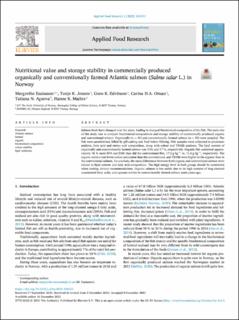| dc.contributor.author | Esaiassen, Margrethe | |
| dc.contributor.author | Jensen, Tonje Kristin | |
| dc.contributor.author | Edvinsen, Guro Kristine | |
| dc.contributor.author | Otnæs, Carina H.A. | |
| dc.contributor.author | Ageeva, Tatiana Nikolaevna | |
| dc.contributor.author | Mæhre, Hanne K | |
| dc.date.accessioned | 2022-01-18T12:37:58Z | |
| dc.date.available | 2022-01-18T12:37:58Z | |
| dc.date.created | 2021-12-16T18:29:08Z | |
| dc.date.issued | 2022 | |
| dc.identifier.citation | Applied Food Research. 2022, 2 (1), 1-32. | |
| dc.identifier.issn | 2772-5022 | |
| dc.identifier.uri | https://hdl.handle.net/11250/2837939 | |
| dc.description.abstract | Salmon feeds have changed over the years, leading to changed biochemical composition of the fish. The main aim of this study was to compare biochemical compositions and storage stability of commercially produced organic and conventional salmon. Organically (n = 40) and conventionally farmed salmon (n = 39) were sampled. The fish were anesthetized, killed by gill cutting and bled before filleting. Fish samples were subjected to proximate analysis, fatty acid and amino acid composition, along with colour and TBARS analyses. The lipid content of organically and conventionally farmed salmon was 13% and 17 %, respectively. Organic fish contained approximately 48 % more EPA and DHA than did the conventional fish, 17.2 g kg−1 vs. 11.6 g kg−1, respectively. The organic salmon had lower colour saturation than the conventional, and TBARS were higher in the organic than in the conventional salmon. To conclude, the main differences between fresh organic and conventional salmon were related to lipid content and fatty acid composition. The high energy level in both groups should be considered when making dietary recommendations. Organic salmon is less stable due to its high content of long-chained unsaturated fatty acids, and appears similar to conventionally farmed salmon some years ago. | |
| dc.language.iso | eng | |
| dc.title | Nutritional value and storage stability in commercially produced organically and conventionally farmed Atlantic salmon (Salmo salar L.) in Norway | |
| dc.type | Journal article | |
| dc.description.version | publishedVersion | |
| dc.source.pagenumber | 1-32 | |
| dc.source.volume | 2 | |
| dc.source.journal | Applied Food Research | |
| dc.source.issue | 1 | |
| dc.identifier.doi | 10.1016/j.afres.2021.100033 | |
| dc.identifier.cristin | 1969601 | |
| cristin.ispublished | true | |
| cristin.fulltext | original | |
